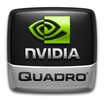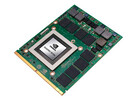NVIDIA Quadro K500M vs NVIDIA Quadro 5010M
NVIDIA Quadro K500M
► remove from comparison
The NVIDIA Quadro K500M is an entry-level, DirectX 11.1-compatible graphics card for mobile workstations. It is a Kepler-based GPU built on the GK107 architecture and is manufactured in 28nm at TSMC. Compared to the K2000M, the K500M only features a 64-Bit memory bus and 192 shader cores instead of 384. The Quadro K500M is built for the Intel Chief River generation (Ivy Bridge) and is the successor to the Fermi-based Quadro 1000M (Huron River platform).
The Quadro series offers certified drivers that are optimized for stability and performance in professional applications like CAD or DCC. OpenGL performance, for example, should be significantly better than GeForce graphics cards of similar specifications.
Architecture
The Kepler architecture is the successor to the Fermi architecture that first appeared in laptops with the GeForce 400M series. The GK107 Kepler core offers two shader blocks, called SMX, each with 192 shaders for a total of 384 shader cores that are clocked at the same speed as the central core. The K500M, however, offers only one SMX with 192 shaders. Although more shader cores are available in the Kepler architecture as compared to the Fermi design, the Kepler shaders are still expected to be up to twice as power efficient. However, due to the missing hot clock of the shader domain, two shaders of a Kepler chip are about as fast as one shader of a Fermi chip (as the latter is clocked twice as fast).
PCIe 3.0 is now supported by the mobile Kepler series and an optional Turbo mode can automatically overclock the Nvidia card by a theoretical 15 percent if the laptop cooling system allows it. The implementation of this boost mode is done in the BIOS, but it is ultimately dependent upon the manufacturer of the laptop.
Performance
The gaming performance should be similar to the consumer GeForce GT 620M.
Features
The improved feature set now includes support for up to 4 active displays. Furthermore, high resolution monitors of up to 3840x2160 pixels can now be connected using DisplayPort 1.2 or HDMI 1.4a if available. HD-Audio codecs, such as Dolby TrueHD and DTS-HD, can be transmitted via bitstream mode through the HDMI port. However, as most laptops will feature Optimus, the integrated GPU will likely have direct control over the display ports and may limit the feature set available by the Nvidia Kepler cards.
The 5th generation PureVideo HD video processor (VP5) is also integrated in the GK107 core and offers hardware decoding of HD videos. Common codecs such as MPEG-1/2, MPEG-4 ASP, H.264 and VC1/WMV9 are fully supported up to 4K resolutions while VC1 and MPEG-4 are supported up to 1080p. Two streams can be decoded in parallel for features such as Picture-in-Picture. Another novelty is the inclusion of a dedicated video encoding engine similar to Intel QuickSync that can be accessed by the NVENC API.
The power consumption of the K500M is rated at 35 Watt (TGP according to Nvidia) and therefore suited for medium-sized notebooks of 15-inches or greater.
NVIDIA Quadro 5010M
► remove from comparison
The NVIDIA Quadro 5010M is a professional workstation graphics card based on the Fermi architecture (GF100 chip). Therefore, the 5010M is closely related to the consumer GeForce GTX 480M. The Quadro 5010M is the successor to the Quadro 5000M and also offers ECC RAM and double-precision floating point cores.
The Quadro series offers certified drivers that are optimized for stability and performance in professional applications like CAD, DCC, medicine, or visualisation areas. The OpenGL performance, for example, should be significantly better than GeForce graphics cards with similar specifications.
The shader / CUDA cores can be accessed using DirectX 11 or OpenGL 4.1 for graphics rendering and DirectCompute, OpenCL, AXE, and CUDA for general purpose calculations. Due to the new Fermi architecture, the 5010M should offer higher levels of performance in general purpose calculations compared to its predecessors.
Furthermore, the Nvidia Quadro 5010M is compatible with the new stereoscopic solution by Nvidia called 3D Vision Pro.
To automatically switch between the integrated graphics card and the Quadro, the 5010M supports Nvidia Optimus. Note, however, that whether this feature is integrated or not depends on the notebook manufacturer.
Similar to the GeForce GTX 480M, the Quadro 5010M is specified at 100 Watt TDP. As a result, only very large laptops, such as the Clevo D901F, are able to house this high-end card.
At the time of arrival (Feb. 2011), the Quadro 5010M succeeds the older Quadrio FX 5000M as the fastest professional workstation graphic card for laptops.
| NVIDIA Quadro K500M | NVIDIA Quadro 5010M | |||||||||||||||||||||||||||||||||||||||||||||||||||||||||||||||||||||||||||||||||||||||||||||||||
| Quadro M Series |
|
| ||||||||||||||||||||||||||||||||||||||||||||||||||||||||||||||||||||||||||||||||||||||||||||||||
| Codename | N14M-Q1 | N12E-Q5 | ||||||||||||||||||||||||||||||||||||||||||||||||||||||||||||||||||||||||||||||||||||||||||||||||
| Architecture | Kepler | Fermi | ||||||||||||||||||||||||||||||||||||||||||||||||||||||||||||||||||||||||||||||||||||||||||||||||
| Pipelines | 192 - unified | 384 - unified | ||||||||||||||||||||||||||||||||||||||||||||||||||||||||||||||||||||||||||||||||||||||||||||||||
| Core Speed | 850 MHz | 450 MHz | ||||||||||||||||||||||||||||||||||||||||||||||||||||||||||||||||||||||||||||||||||||||||||||||||
| Memory Speed | 1800 MHz | 1300 MHz | ||||||||||||||||||||||||||||||||||||||||||||||||||||||||||||||||||||||||||||||||||||||||||||||||
| Memory Bus Width | 64 Bit | 256 Bit | ||||||||||||||||||||||||||||||||||||||||||||||||||||||||||||||||||||||||||||||||||||||||||||||||
| Memory Type | DDR3 / GDDR5 | GDDR5 ECC | ||||||||||||||||||||||||||||||||||||||||||||||||||||||||||||||||||||||||||||||||||||||||||||||||
| Max. Amount of Memory | 2048 MB | 4 GB | ||||||||||||||||||||||||||||||||||||||||||||||||||||||||||||||||||||||||||||||||||||||||||||||||
| Shared Memory | no | no | ||||||||||||||||||||||||||||||||||||||||||||||||||||||||||||||||||||||||||||||||||||||||||||||||
| API | DirectX 11, Shader 5.0, OpenGL 4.3 | DirectX 11, Shader 5.0 | ||||||||||||||||||||||||||||||||||||||||||||||||||||||||||||||||||||||||||||||||||||||||||||||||
| Power Consumption | 35 Watt | 100 Watt | ||||||||||||||||||||||||||||||||||||||||||||||||||||||||||||||||||||||||||||||||||||||||||||||||
| Transistors | 1.3 Billion | 3 Billion | ||||||||||||||||||||||||||||||||||||||||||||||||||||||||||||||||||||||||||||||||||||||||||||||||
| technology | 28 nm | 40 nm | ||||||||||||||||||||||||||||||||||||||||||||||||||||||||||||||||||||||||||||||||||||||||||||||||
| Features | Optimus, PhysX, Verde Drivers, CUDA, 3D Vision, 3DTV Play | OpenGl 4.1, ECC Memory, FP64 IEEE 754 | ||||||||||||||||||||||||||||||||||||||||||||||||||||||||||||||||||||||||||||||||||||||||||||||||
| Notebook Size | medium sized | large | ||||||||||||||||||||||||||||||||||||||||||||||||||||||||||||||||||||||||||||||||||||||||||||||||
| Date of Announcement | 01.06.2012 | 22.02.2011 | ||||||||||||||||||||||||||||||||||||||||||||||||||||||||||||||||||||||||||||||||||||||||||||||||
| Information | 118mm2, CUDA, OpenCL 1.2, OpenGL 4.3 | |||||||||||||||||||||||||||||||||||||||||||||||||||||||||||||||||||||||||||||||||||||||||||||||||
| Shader Speed | 900 MHz | |||||||||||||||||||||||||||||||||||||||||||||||||||||||||||||||||||||||||||||||||||||||||||||||||
| Link to Manufacturer Page | www.nvidia.com |


 Deutsch
Deutsch English
English Español
Español Français
Français Italiano
Italiano Nederlands
Nederlands Polski
Polski Português
Português Русский
Русский Türkçe
Türkçe Svenska
Svenska Chinese
Chinese Magyar
Magyar











